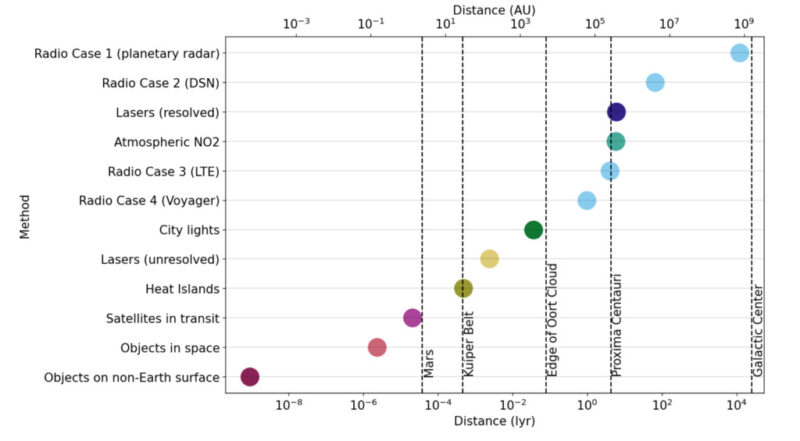How easy is it to see Earth’s civilization?
Could an alien civilization with technology like ours detect us looking back at them? What would aliens see? And from how far away could they see it? Knowing how easy Earth and earthlings are to spot might simplify work for scientists looking for alien life. The SETI Institute said on February 3, 2025, that certain signatures from Earth could be seen nearly as far away as the center of the Milky Way galaxy.
The researchers published their peer-reviewed study in The Astronomical Journal on February 3, 2025. Its conclusions might provide a guide for finding ET.
Co-author Macy Huston of the University of California, Berkeley, said the study of signs of humanity could be revealing:
Our goal with this project was to bring SETI back ‘down to Earth’ for a moment and think about where we really are today with Earth’s technosignatures and detection capabilities. In SETI, we should never assume other life and technology would be just like ours, but quantifying what ‘ours’ means can help put SETI searches into perspective.
The 2025 EarthSky lunar calendar makes a great gift. Get yours today!

Simulating humanity’s galactic technosignature footprint
Human beings can be a noisy bunch. We’ve been intentionally and unintentionally sending messages to anyone who can hear them for more than a century. And we’ve used many different wavelengths to announce our presence.
So the paper’s authors thought it might be helpful to suppose other civilizations are just as boisterous. Our lasers and radios, city lights and spacecraft, atmospheric pollutants and even our cities signal to the rest of the galaxy that we’re here. Researchers modeled the combined effects into a mirror Earth. Seekers after other intelligences might find it of use for their own quest for ET.
Yet the authors added a caution:
It should be noted that the idea of a mirror Earth or Earth-level extraterrestrial intelligence is not meant to be taken literally but is instead a helpful framing device. There is no universal technological level or single civilization on Earth. We cannot assume that convergent technological or biological evolution would be at play across the galaxy, and the ‘present’ level of technology rapidly changes.
In other words, we might find aliens that do some of the things we do. But don’t expect a parallel Earth where Spock and Kirk would be happy to go adventuring.
Making a good first impression for the aliens
SETI seeks signs of not just ET, but intelligent civilizations. What they yearn to find is some unnatural energetic event. They’re searching for intentional signals and obvious artificial patterns. Knowing how we might appear to other observers might give clues to finding such signals.
Lead author Sofia Sheikh of the SETI Institute explains:
One of the most satisfying aspects of this work was getting to use SETI as a cosmic mirror: What does Earth look like to the rest of the galaxy? And how would our current impacts on our planet be perceived? While of course we cannot know the answer, this work allowed us to extrapolate and imagine what we might assume if we ever discover a planet, with, say, high concentrations of pollutants in its atmosphere.

How bright does human civilization shine for aliens?
The noise humanity makes is mostly in the form of electromagnetic radiation. Our signals are sent to space by radio waves of various kinds and strengths. Communications lasers beam our messages skyward too. And there are other signs, like orbiting satellites and the heat from our cities. The researchers looked at all of the signals and how far away they could be detectable.
Broadcasting from the former Arecibo Observatory might have been a mistake, if hostile aliens are listening. The signal it and other scopes like it generate have the power to reach as far as 12,000 light-years, the researchers found. That’s all the way the star-packed central region of the Milky Way.
No reason to worry, of course. The signals we send take 12,000 years to arrive. And they’re the only broadcasts we make that can carry so far. Yet Deep Space Network signals to our spacecraft have already reached alien suns. They can eventually travel as far as 65 light-years before losing coherence.
More signatures detectable from closer stars
Any civilization on the closest star – Proxima Centauri – could detect a range of other signs we exist. Some kinds of laser beams – used for detecting and analyzing materials – have enough power to travel the 4.36 light-years that separate us. Some radio broadcasts can also bridge that gap. And they can even see how dirty we’ve made Earth’s air, the research paper explains:
There are other atmospheric technosignatures in Earth’s atmosphere that have very few or even no known nontechnological sources. For example, chlorofluorocarbons, a subcategory of halocarbons, are directly produced by human technology (with only very small natural sources), e.g., refrigerants and cleaning agents, and their presence in Earth’s atmosphere constitutes a nearly unambiguous technosignature.
So if we know what Earth’s atmosphere looks like as seen from a distance – perhaps as viewed by a sun-observing spacecraft like the recently-launched Proba-3 – we might find clues to what alien industriousness could leave behind.
Bottom line: Researchers looking for alien life say Earth might be detectable by ETs with tech like our own. Our civilization can be seen from 12,000 light-years away.
Read more: Do aliens exist? What scientists really think
Read our previous article: What’s in the sky this week from February 7 to 14, 2025